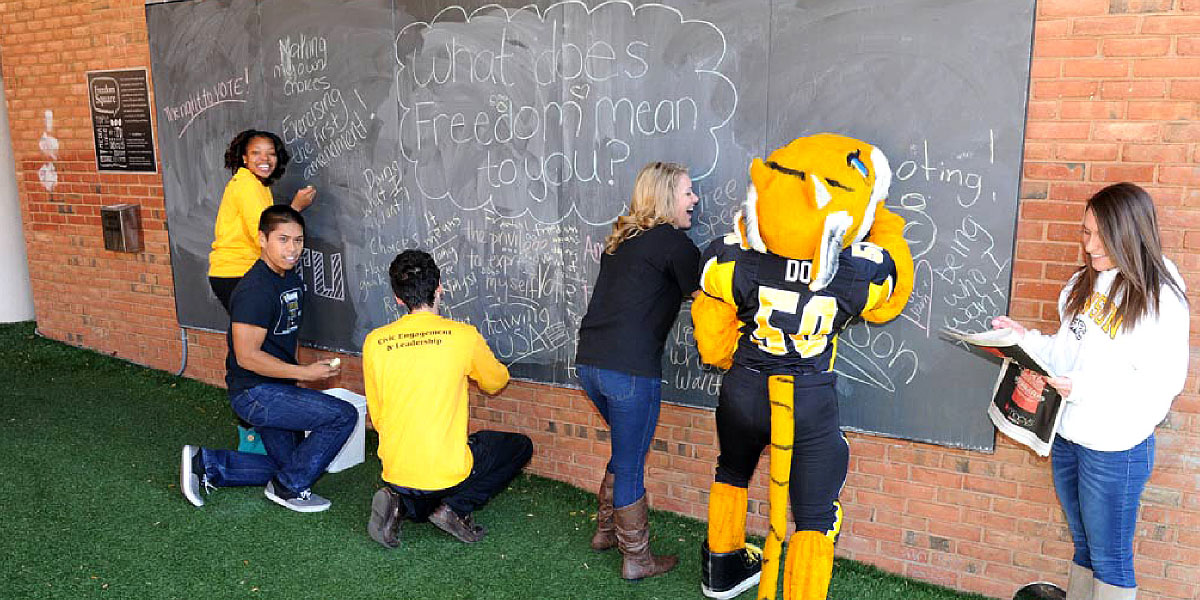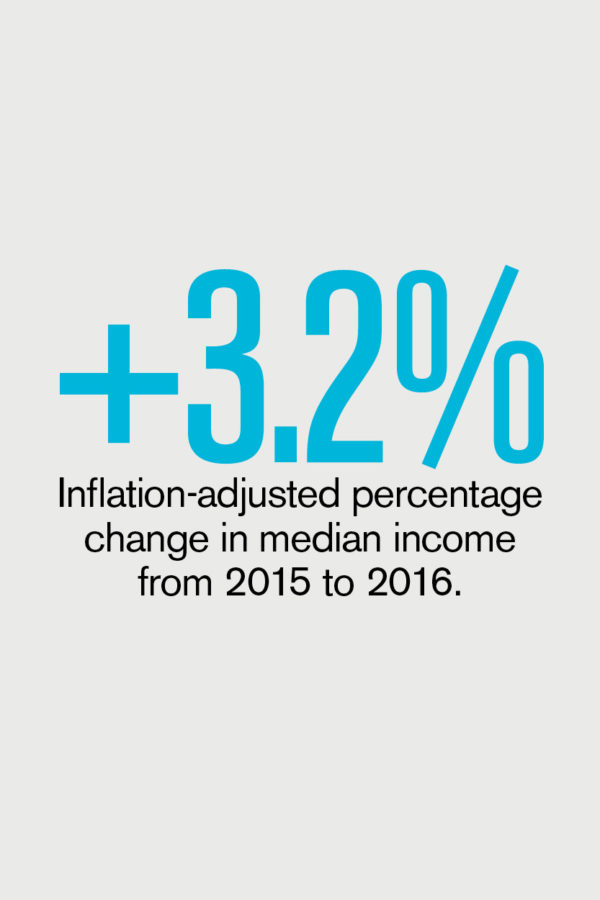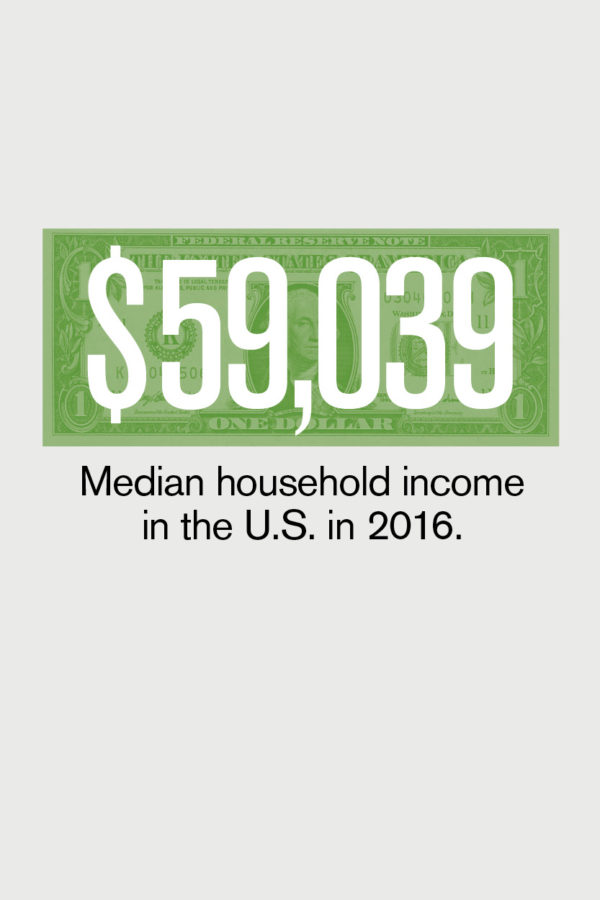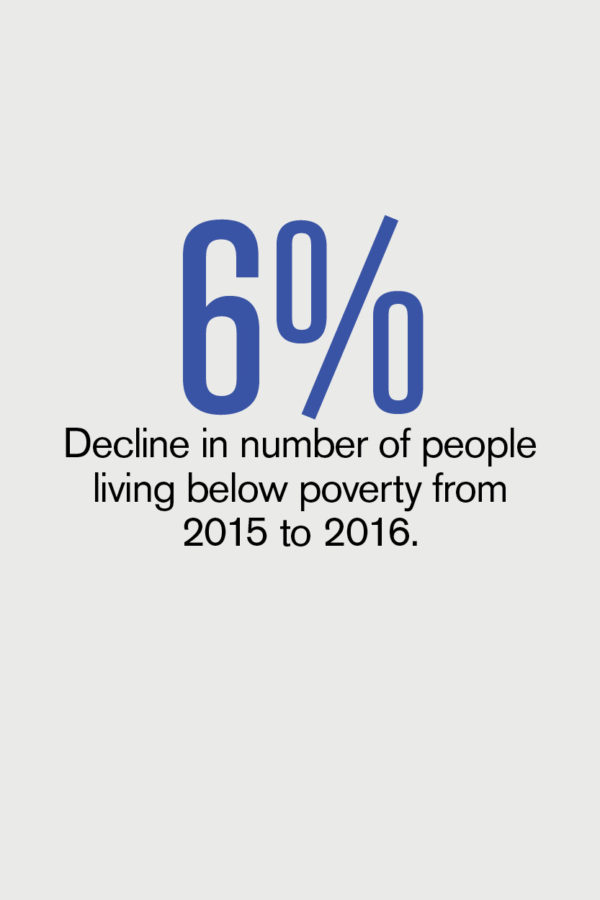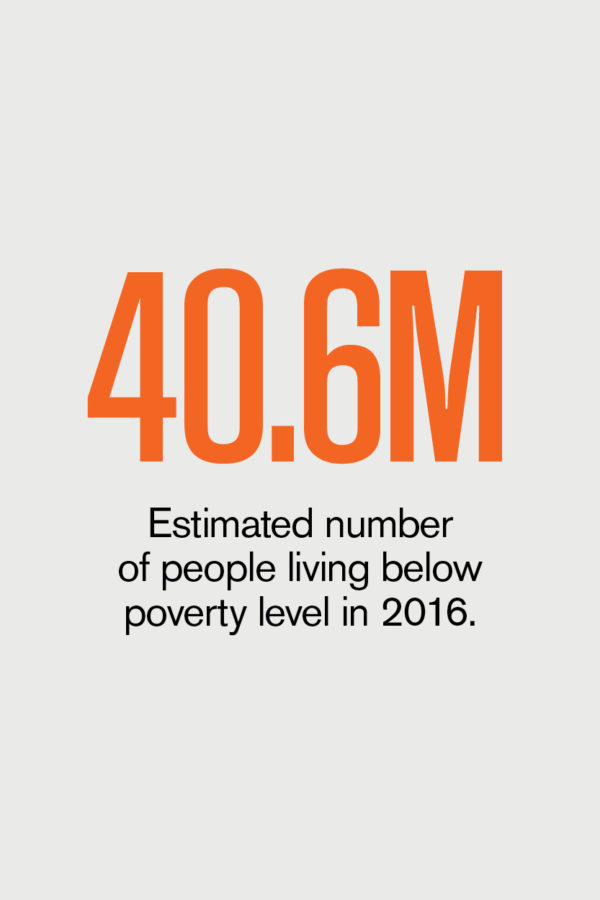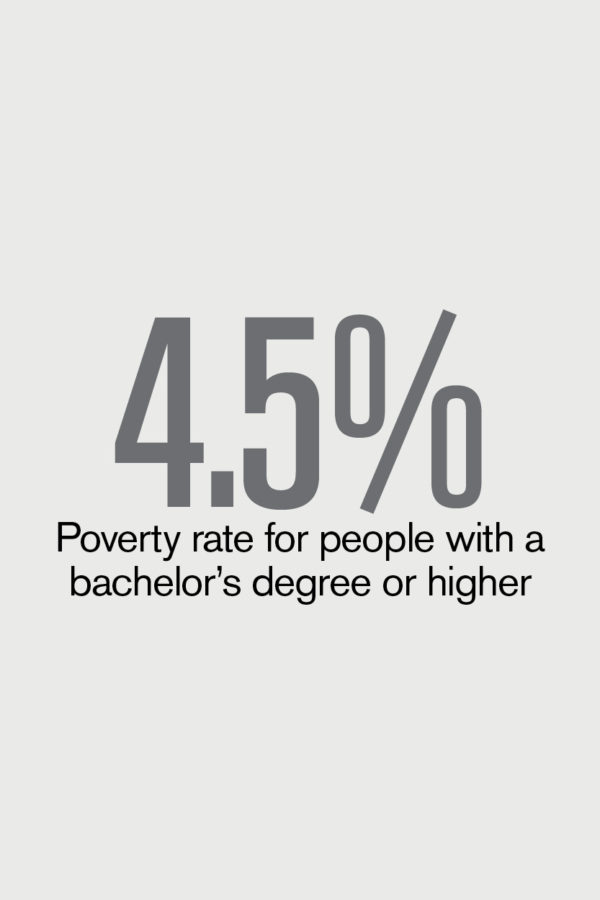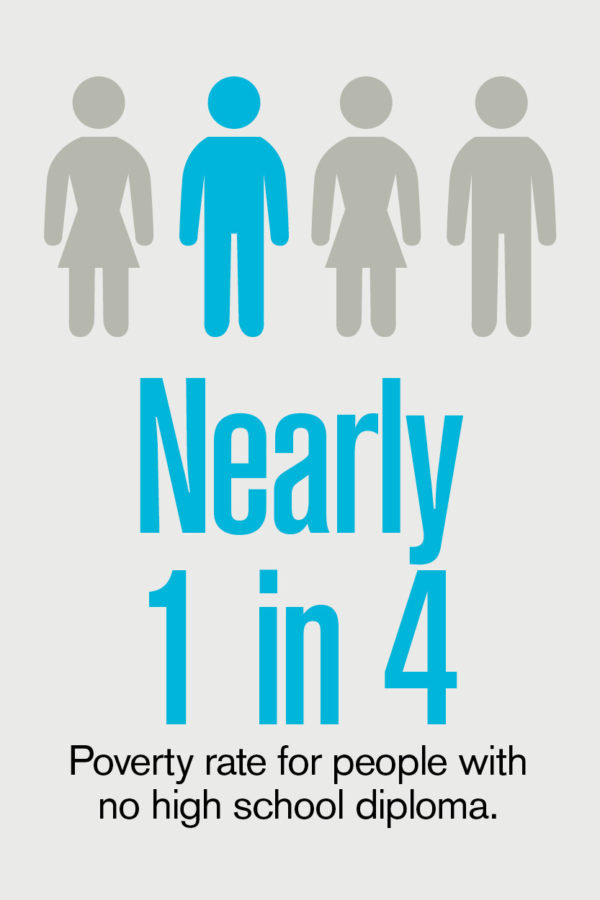As anchors in their communities, higher education institutions have long internalized as a core value the need to be a good neighbor and to consider the well-being of the populations and the places beyond their campus borders. Modeling this ethic for students has likewise been part of the mission for many institutions, with civil discourse being a key component.
While civil discourse is not only a virtue but a bedrock of any democratic society, an increasingly polarizing rhetoric has taken hold throughout the nation in recent years that has largely cemented diametrically opposed mindsets on a host of political and social concerns—often spilling into the town-gown relationship. As such, it has become all the more important to revisit the art of how we talk to one another—to engage in curious, open-minded debate that seeks common solutions to the challenges that impact all Americans.
Across the country, colleges and universities are encouraging a new generation of students to explore their civic responsibility. The upcoming November Business Officer will highlight how a handful of higher education institutions are working to reanimate concepts of civic engagement within campus life and the curriculum. As a recipient of the Carnegie Foundation for the Advancement of Teaching’s Community Engagement Classification, Towson University (TU) in Maryland serves as one example for its emphasis of collaborative learning and practice aimed at deepening the civic understanding and participation of its students.
In and of the Community
Simply put, “Towson University matters to Maryland, and Maryland matters to Towson University.” The relationship is not one of mere convenience but of mutual benefit and well-being, suggests Christopher Jensen, director of Towson University’s Office of Civic Engagement and Social Responsibility. Upwards of 80 percent of the university’s student population hails from the state, and most TU graduates remain in Maryland, notes Jensen. The concerns of the campus community and the larger community are therefore often one and the same.
That’s also why a significant focus of the work of Jensen’s office includes promoting democracy through service within the larger community. “Our civic engagement commitment falls squarely within our value of community engagement. We want to maintain the trust of our community and state by being a good neighbor, and to have our students think about their civic commitments in terms of community engagement and service.”
Tracking Opportunities
One current undertaking for the university is compiling a database of the numerous faculty- and student-led collaborations within the community—from tutoring and language translation services to grantwriting assistance benefiting public schools and nonprofit agencies that also provide valuable experience for TU students.
“We want to support these existing community relationships in meaningful ways wherever we can,” says Jensen. Foremost, that entails tracking current resources and capacity to see where those partnerships can be leveraged for greater impact by connecting groups and individuals who may be doing similar things.
“Right now we are in a knowledge-gathering stage to develop a framework for everyone to know about these different initiatives. What we don’t want is for a good program to go by the wayside when a faculty member retires, simply because we didn’t know about it. That can leave a hole in a vital community need,” adds Jensen.
In the span of 10 years, TU’s Office of Civic Engagement and Social Responsibility has grown from a single cubicle to its current staff of 10, including five employees, four graduate assistants, and an AmeriCorps volunteer. In 2013, Jensen became the first full-time director of the office, a joint venture between academic and student affairs. In addition to robust community engagement efforts, the office also partners with the university’s office of sustainability on campus environmental activities and with student government on a variety of political engagement initiatives—not the least of which includes generating opportunities for more dialogue across campus about political and social concerns, notes Jensen.
Conversation Starters
Dialogue opportunities that TU promotes include:
- New York Times Talks. To encourage an informed campus population, the university sponsors a collegiate readership program that gives students and faculty members subscription access to The New York Times, USA Today, and The Baltimore Sun. On average, twice each month the Office of Civic Engagement and Social Responsibility also hosts a one-hour New York Times Talk for a facilitated discussion on a pre-selected topic.
“We try to pick a timely national or international topic, but this can still be tricky because the news cycle can change so quickly from one week to the next,” admits Jensen. The talks typically draw between 30 to 40 students and faculty.
Often a faculty member who has some expertise or has done some research on the topic leads the discussion. Among the topics that Jensen considers as likely contenders for the fall 2017 term include second amendment rights, immigration/DACA (Deferred Action for Childhood Arrivals), freedom of religion, and free speech.
- Campus Conversations. These monthly discussions usually take on a more local flavor, reflecting concerns and interests about what may be happening on campus or in the local community. “We don’t try to steer away from sensitive or controversial issues,” notes Jensen. Last year several campus conversations addressed the Freddie Gray arrest and ensuing riots and protests, allowing participants to discuss how these events were impacting students and faculty and their families and friends.
Campus conversations can range from a dozen to several hundred participants and are typically held in the university’s student union, in a residence hall, or in a classroom.
- Freedom Square. TU’s designated free speech area was developed in 2011 at the heart of campus to provide a venue for student debates and informal gatherings. “Freedom Square is not intended for organized demonstrations or protests and is not available for external stakeholders to host events,” says Jensen. The university is currently assessing a speaker system that students can request for events, so that individuals can be heard across a larger crowd in a normal voice without resorting to yelling, and at a decibel level that also doesn’t disturb nearby classroom activity, explains Jensen.
One prominent feature of Freedom Square is a giant chalkboard where campus community members can post comments. Each “Thoughtful Thursday” poses a new question—such as “What does unity mean to you?”—allowing anyone to add a response.
“While a chalkboard is visually interesting, for a variety of reasons, we are exploring how to expand or extend this conversation medium, since it limits the space available for posting ideas and comments and doesn’t easily allow for archiving the full collection of responses,” says Jensen. Digital signs are one option. Social media platforms like Facebook and Twitter would also allow participation by students who may not be physically present on campus, notes Jensen.
With 19,400 undergraduates, trying to develop venues for conversations that engage the entire TU community remains an ongoing challenge, admits Jensen. Yet, wherever possible, the university’s goal is to promote dialogue across a broad range of ideas that is respectful and meaningful and includes a diversity of perspectives. As important, says Jensen, is providing opportunities for students to feel they are being heard and to practice listening to what others think.
SUBMITTED BY Karla Hignite, New York City, contributing editor for Business Officer
It Isn’t Easy Remaining Green
According to the U.S. Green Building Council, as of July 2017, more than 4,000 higher education buildings projects had been certified. The Student Activity Center (SAC) at the University of Texas at Austin (UT Austin), which just marked five years since achieving USGBC’s Leadership in Energy and Environmental Design (LEED) gold rating, is among them.
At 156,772 gross square feet of space, the SAC includes dining, event, and meeting spaces; casual lounges; outdoor gathering spaces; a 466-seat multiuse auditorium; and a 150-seat black box theatre. University Unions manages three of the five floors in the SAC, while UT Austin’s staff handle the day-to-day management of the remaining two floors in the building.
“It was a perfect storm between the administration and students,” says Nick Parras, an assistant director at University Unions, of the decision to take a green approach to designing and building the new facility. “When the SAC was being designed and built, the university’s sustainability policy was already in place.”
Setting Policy
Established in 2009 by Vice President for University Operations Pat Clubb, in participation with the Clinton Global Initiative, the university’s sustainability policy stipulates that all new buildings be designed to achieve the LEED silver standard as defined by the U.S. Green Building Council.
The university was awarded its first LEED certification in 2007 for the construction of the Research Office Complex. To achieve LEED certification for the ROC facilities, the university established performance goals in five categories: (1) sustainable sites, (2) water efficiency, (3) energy and atmosphere, (4) materials and resources, and (5) indoor environmental quality.
Similar factors were key considerations for the SAC construction project as well. Some of the SAC’s green building/construction components include incorporating green roofs to reduce and slow the amount of stormwater leaving the site; installing CO2 monitors in all assembly spaces to ensure the proper amount of fresh, outside air during occupancy; and recycling more than 75 percent of construction waste. “The Student Activity Center/Liberal Arts Phase 1 Building Committee had a lot of opportunities to be different, creative, and cutting edge from a design perspective,” Parras says.
At the same time, Parras acknowledges there have been challenges, particularly in regard to the cistern system that was incorporated in the original building design. When fully functioning, it collects and recycles rainwater from the roof to supply water and irrigation to the rest of the building. However, due to problems encountered after construction and the warranty period concluded, the cistern system is not being used to its capacity. “We plan to get it back and running again,” Parras says. “We want it to be a truly self-sustaining system that doesn’t use local water, but runs using recycled, reclaimed water.”
Achieving Goals
However, overall, the project has been successful. According to data gathered by the university’s Utilities and Energy Management Department, which measures and tracks each campus facility’s site energy utilization index (EUI), the SAC is three years ahead of schedule in meeting the institutionwide goal of reducing energy emissions by 20 percent by 2020. Site EUI is calculated by taking a unit of energy consumption and dividing it by the square footage of a facility, using a year’s worth of data. The baseline year used for establishing the overall goal for energy emissions reduction is 2009, when the campus’s average site EUI was 200, making the goal rating 160. The SAC’s current rating is 161, and the goal is for it to be even lower.
Campus Energy Manager Amanda Berens is among those who will be working on achieving this standard over the next year. “We have our own power plant on campus, and we also have multiple chiller plants,” Berens explains. “We send chilled water, steam, and electricity to the facilities on campus, and we have a meter for each building. We’re measuring this at the SAC.”
According to Berens, the objective of tracking utility data is to review energy usage for all buildings and investigate why it’s higher for some users. “For example, what are the high energy users on the two floors the university manages?” she says. “We’ll work with them initially to lower their usage and then partner with University Unions to address energy use on the remaining floors.” To maximize energy efficiency in a building like the SAC, Berens and others will work to reduce energy use in other areas, such as offices, to compensate for the use of kitchen equipment and hours of use (7 a.m. to 3 a.m. during the semester) that are different from other buildings on campus.
Maintaining Momentum
Both Parras and Berens agree that getting the maximum return on investment from green building construction projects requires ongoing management of the systems designed to save energy and financial resources. They know firsthand that even the most successful of green building projects encounter stumbling blocks.
Your institution may experience challenges before, during, or after completing construction on a green building. However, following the University of Texas at Austin’s example, there are steps you can take to mitigate them and stay on track with your sustainability goals.
- Be aware of costs. “You have to put a price point to altruistic goals,” Parras emphasizes. “Students want to change the world, but they need to understand the one-time and recurring costs associated with green building projects.”
- Communicate what you’re doing and why. “This helps people on campus deal with disruptions in their routines a little better,” Parras said. He points to the “door project” as a good example of the need for ongoing communication. The doors were in an area near a coffee shop, and often the line of people waiting for their coffee would unintentionally keep the doors open.
“With the doors, the hard part was swapping out the custom sliding doors that killed our HVAC system,” he explains. “We picked our most popular doors, so we had to communicate with students, so they understood the reasons behind the change.”
- Continue to communicate after the project is completed. “We tried to emphasize green features of building a lot in the beginning, but you have to find ways way to continue that conversation to promote and push those features after construction,” Parras notes.
- Involve students throughout the project. “Students on the steering committee were very interested in the sustainability aspect of this project from the very beginning,” says Parras, who describes the SAC as a “living laboratory for students.” As such, various efforts were made to include students in the project, such as hosting a tour for architecture students and showing them the HVAC, which resulted in their doing some projects around that system. Mechanical engineering students also conducted a semester-long project working with University Unions staff.
- Fine-tune and increase use of your climate control system capabilities. “For example, institutions can use their computerized control systems to optimize the use of air conditioning during off hours in strategic locations,” Berens says. “You also can fine-tune lighting controls based on occupancy levels in different areas by verifying that your lighting control system is working properly.”
“Even if it’s a new building, LEED certified, and well-controlled, it’s still worth evaluating how those controls are working on an annual basis to make sure the facility is operating in ways that you would expect,” Berens adds. “There’s always room for improving how your system is being used.”
SUBMITTED BY Apryl Motley, Columbia, Md., who covers higher education business issues for Business Officer.
How does your campus handle change? When asked that question in an on-the-spot survey during the NACUBO 2017 Annual Meeting session “How to Start a Grassroots Movement,” 80 percent of the attendees said their institutions favored a traditional top-down approach. In other words, they look to senior management to identify challenges and solutions and then issue directives.
The University of California, Riverside (UCR) flipped that model when it launched an organizational excellence (OE) initiative in 2015. Staff were empowered to identify ways to improve productivity and use of resources, which were then presented to management. “It’s not as risky as you might think—people came up with many of same things we would have told them to do,” noted Ron Coley, UCR’s vice chancellor of business and administrative services. “But rather than pressing change onto staff members, and having them bend under the pressure, we wanted them to help bake solutions into the culture.”
UCR launched its three-stage organizational initiative with a series of workshops designed to create ownership among staff and develop a collective campus voice. After hearing speakers from other institutions share OE-related experiences, participants met in small groups to consider how they might apply the method in their own environments. “We used instantaneous feedback during the sessions to show participants, in their own words, what they had identified as pain points and what they wanted to achieve,” said Kimberly Villanueva, interim director of strategic project management at UCR.
Engagement and Enthusiasm
Four priorities, which came to be known as the four pillars of OE, emerged from these grassroots sessions: standardize business processes, maximize leadership and professional development, instill a culture of collaboration and innovation, and streamline business processes. The second stage of UCR’s initiative built momentum among staff to address these areas. Rather than assigning each one to a vice chancellor to address, the university:
- Formed workgroups related to each area, all with self-selected members. The workgroups appointed their own chairs—not necessarily the senior leaders who would have been tapped in a top-down approach—and began researching and drafting recommendations. Jason Rodriguez, strategic initiatives analyst at UCR, reported a noticeable shift in campus mentality. “We started to see a sense of ownership and creativity across campus, as people were encouraged to think outside their everyday responsibilities,” he explained.
- Appointed 70 staff members as OE Ambassadors. These volunteers, many of whom are frontline staff, deliver and promote messages to various departments and facilitate discussions during campuswide events and forums on topics such as improving collaboration.
- Organized an OE Showcase to build campus support and excitement. Attended by more than 350 staff, faculty, and students, the event highlighted progress on nine projects that had grown out of staff’s recommendations.
One project, for example, integrated two 200-person teams of facilities service employees into one streamlined organization. The restructuring process not only collapsed overhead and infrastructure but created 42 new positions. Another workgroup developed consistent policies and procedures for hosting events and conferences on campus. Still another focused on LEAN thinking; UCR now hosts a LEAN Book Club to support staff members interested in learning about, discussing, and applying Kaizen principles.
Continuing the grassroots momentum represents the third stage of the overall initiative. In response to requests for more professional development, UCR created an OE certification program. The first tier, or bronze level, provides participants with the OE skillsets to promote excellence and facilitate grassroots change.
Two additional tiers—the program’s silver and gold levels—are still being developed; the new levels will help UCR staff apply their knowledge to specific projects and provide OE mentoring, coaching, and networking opportunities.
RESOURCE LINK Additional information is available at http://oe.ucr.edu.
MORE ANNUAL MEETING HIGHLIGHTS Read more about speaker and session content in “Midwest Motivation.”
SUBMITTED BY Sandra R. Sabo, Mendota Heights, Minn., who covers higher education business issues for Business Officer.
“In spring 2017, 25 percent of students surveyed reported using a free method to obtain what [course materials] they needed for class, up from 19 percent in spring 2016 and 15 percent in spring 2015.”
–Student Watch: Attitudes and Behaviors Toward Course Materials, National Association of College Stores twice-yearly survey of college students.
Fast Fact
Public Safety Training Tools
To coincide with National Campus Safety Awareness Month, in September, the Clery Center and its project partner Allied Universal rolled out a series of video-based roll call training tools for campus public safety personnel. The First Step: Public Safety Roll Call Video Series, created by the Clery Center, consists of a suite of free five- to ten-minute videos, with accompanying companion guides.
The training modules build on Allied Universal’s Higher Education Academy, and feature learning principles and quizzes that assess mastery of the subject matter. Campus topics include sexual assault and higher education law, communicating with the campus community, the role of campus security authorities under the Clery Act, and several others.
The project was made possible by the joint partnership announced earlier this year. Reflecting on the initiative, Alison Kiss, Clery Center executive director, noted, “We hope these videos spark important campus conversations about how officers can best connect with and support members of their own unique campus communities and open the door to more in-depth training on these critical topics.”
News—or Not?
With a multitude of media sources, slants, and spins, how do young people—or adults, for that matter—learn ways to validate news and understand the importance of news sources? One way is to participate in National U.S. “Media Literacy Week,” November 6–10. Hosted by the National Association for Media Literacy Education, the event is intended to raise awareness about the need for media literacy education and its essential role in education.
The third annual event will launch on November 6 and is hosted by Reuters, New York City. Bringing together journalists, educators, and researchers, the goal is to outline ways in which students can develop critical thinking skills around news and media. Twitter headquarters in San Francisco will be the site of the wrap-up event on November 10.
![]()
By The Numbers
Income and Poverty in the United States
Source: U.S. Census Bureau, Income and Poverty in the United States. Available online at www.census.gov/content/dam/Census/library/publications/2017/demo/P60-259.pdf



